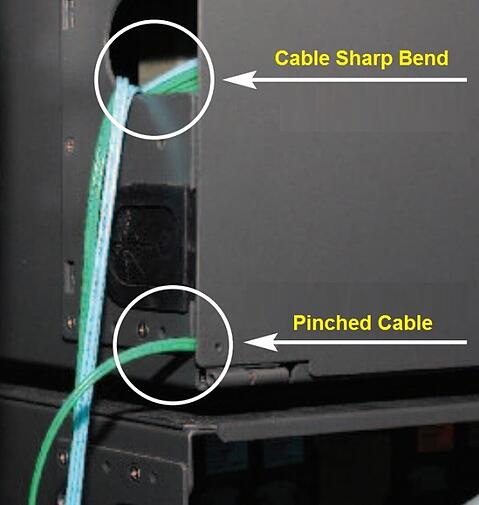Bending Loss: A Risk Associated with Reusing Installed Fiber Cable
Thanks to its ultra-high data transmission capacity, ultra-low loss and installation flexibility, glass optical fiber is the most power-efficient data transmission media available today. Optical fiber cables have been deployed worldwide to connect people and “things” together.
According to CRU’s Optical Fibre and Cable Monitor, last year, the global optical cable demand reached 318 million kilometers in the first three quarters of 2016.
Two types of optical fiber are available for different network environments and link distances:
- Multimode fiber (MMF) for short-reach links up to a few hundred meters, mainly used in data centers environments
- Singlemode fiber (SMF) for long-reach links, such as in LANs, access networks, metro/transport networks and hyperscale data centers

Fiber cables are typically installed and owned by internet service providers or internet content providers (including cloud service providers), or enterprise IT departments. People commonly believe that fiber cable has unbounded bandwidth capacity and can last forever; however, with the recent data traffic boom – cloud services, over-the-top content delivery and Internet of Things (IoT) – some old fiber infrastructure has hit its capacity limit and needs to be upgraded.
This blog is the first of three in a series where we will walk you through the risks of reusing installed fiber cable, and help you understand how fiber cable infrastructure performance and quality could impact your business operations.
Macro-Bending & Bend-Insensitive Fiber
Optical fiber cables are recognized as the superior data transmission media over long distances. The optical fiber is a waveguide that confines light within the fiber core, which is bounded by the cladding material that prevents light from escaping.

Source: IBM
Compared to copper cable, optical fiber cable has a much smaller cross-section diameter to support flexible cable routing and installation, especially for high-density I/O. Nevertheless, strict fiber cable installation rules have to be followed because light can leak out of the fiber core through the cladding when bent or wrapped. Bending loss occurs when a fiber cable bend is tighter than its maximum bend tolerance; bending loss is due to physical bends that are large in relation to the diameter of the cable. As the bend tightens, more light is lost. This phenomenon is referred to as “fiber macro-bending.”
TIA 568.3-D specifies the minimum bend radius for fiber cable installation to avoid excessive “light leakage” or bending loss—
"Cables with four or fewer fibers intended for cabling sub-system shall support a minimum bend radius of 25 mm (1 in) when not subject to tensile load. Cables with four or fewer fibers intended to be pulled through pathways during installation shall support a minimum bend radius of 50 mm (2 in) under a pull load of 220 N (50 lbf). All other inside plant cables shall support a minimum bend radius of 10 times the cable outside diameter or less when not subject to tensile load, and 20 times the cable outside diameter or less when subject to tensile loading up to the cable’s rated limit."
Macro-Bending Hurdles in New Use Cases
 In many new practical use cases, fiber cables are required to be installed with even smaller bend radii, which could lead to bending loss:
In many new practical use cases, fiber cables are required to be installed with even smaller bend radii, which could lead to bending loss:- In access networks, optical fiber is installed closer to subscribers; therefore, smaller bend radius is required to support high-density, flexible fiber installation and routing.
- In data center networks, more and denser fiber cables are installed to support ever-growing bandwidth requirements in limited space; therefore, hassle-free fiber cable installation with higher bend tolerance is increasingly important to reduce bending loss and speed up data center deployment and upgrades.

Legacy fiber cable, although optimized for low-attenuation data transmission, is subject to excessive transmission loss; it was not optimized to support sharp bends and can suffer from bending loss. Accidental fiber loss can happen on a daily basis if care is not taken:
- Sharp bend: severe 90-degree bend can induce high link loss of up to 0.4 dB to 0.5 dB
- Pinched cable: pinching standard fiber jumper can lead to an attenuation of 3 dB to 4 dB
- Fiber slack loop: a tight pulling tension on the fiber jumper can cause an attenuation of >5 dB
Source: Anixter
Fibers with Enhanced Macro-Bend Loss Performance: Bend-Insensitive Fibers
Recently, bend-insensitive SMF and MMF (BI-SMF and BI-MMF) products have been introduced to the market to meet the needs of tighter fiber-bend tolerance to avoid bending loss. Optical fiber manufacturers used a refractive index “trench” in the fiber structure—a ring of lower refractive index material—to reflect lost light back into the core of the fiber.
Industry standards have also been developed to specify the bend-radius tolerance of BI-SMF and BI-MMF.
- BI-MMF: ISO/IEC 60793-2-10 provides specifications for A1a.1b, A1a.2b, A1a.3b and A1a.3W that support two turns of 15mm bending radius with <0.1 dB loss at 850nm and two turns of 7.5mm bending radius with <0.2 dB at 850 nm. (BI-MMF cables are only optimized for 850nm but not for 1300nm. While the bend loss at 850nm is as described above, the results at 1300nm are not much different than with standard 50µm MMF.)
- BI-SMF: ISO/IEC 60793-2-50 provides specifications for B6 singlemode fibers that can support minimum bending radius of 10mm, 7.5mm and 5mm. The same recommendation has also been made in the ITU-T G.657 standard document. (G.657.A1 and G.657.A2 are fully compliant with traditional SMF standard G.652.D with lower fiber transmission loss; G.657.B2 and G.657.B3 are compatible with G.652.D with smaller minimum bending radii, but the transmission loss is slightly higher.)
Using bend-insensitive fiber cable will minimize the risks of fiber bending loss, and reduce accidental system downtime by considerably improving link robustness and overall performance.
Given the installation and maintenance advantages, considering BI-MMF and BI-SMF for system upgrades or new fiber cable deployment is highly recommended.
Belden offers BI-MMF and BI-SMF fiber products that are faster, easier and better to use. Our fiber connectivity solutions reduce complexity, increase flexibility and streamline installation.
